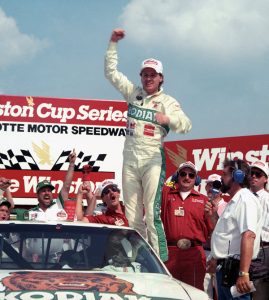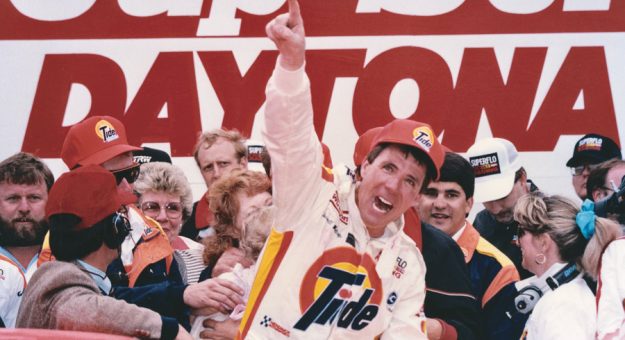Editor’s Note: NASCAR is celebrating its 75th anniversary in 2023. SPEED SPORT was founded in 1934 and was already on its way to becoming America’s Motorsports Authority when NASCAR was formed. As a result, we will bring you Part 42 of a 75-part series on the history of NASCAR as told in the pages of National Speed Sport News and SPEED SPORT Magazine.
Rusty Wallace made a promise at the end of 1988. After winning the season ending race at Atlanta Motor Speedway and finishing 24 points behind champion Bill Elliott, Wallace vowed to “thrash” Elliott and win the title for himself in 1989.
Wallace found out promises are not easy to keep.
The green flag waved over the season Feb. 19 as a field of 42 cars started the Daytona 500 at Daytona lnt’l Speedway. Dale Earnhardt and Ken Schrader led the field with 10 laps remaining, but when they pitted for a splash of fuel, Darrell Waltrip took the lead en route to his first Daytona 500 victory.
Waltrip led Schrader, Earnhardt and Geoff Bodine across the stripe for a one-two-four finish for cars owned by Rick Hendrick.
Wallace rebounded from a disappointing 18th-place finish to win at North Carolina Motor Speedway two weeks later. Wallace, who led 222 of the 492 laps around the Rockingham, N.C., superspeedway, pitted with 10 laps remaining for fresh tires.
Earnhardt left his pit stall at the same time and tried to block Wallace in a move for the lead, but Wallace squeezed between the No. 3 and the wall and earned his 11th career victory.
“Dale’s crew is fast and I didn’t want him to get ahead of me on the track,” said Wallace in the March 8 National Speed Sport News. “When the car dropped off the jack, I stood on it. Dale did what I expected him to do. He pulled out and tried to block me. I wasn’t going to let up.”
Wallace’s engine let go after 217 laps at Atlanta and Waltrip won the race, while point-leader Earnhardt finished second.
Wallace rebounded and won at the three-quarter-mile Richmond (Va.) Raceway with a quicker final pit stop than runner-up Alan Kulwicki and third-place Earnhardt. Richard Petty endured a frustrating day as he sat at home on a Winston Cup race day for the first time in more than 18 years.
The 51-year-old did not qualify for the Richmond race, halting his streak of 513 consecutive Cup Series starts. The streak had begun Nov. 14, at Richmond.
Harry Gant ended his frustrating streak of 90 races without a victory with a triumph at Darlington (S.C.) Raceway on April 5. Wallace was eighth in that race, but endured a record 20 caution flags the following weekend at Bristol (Tenn.) Motor Speedway. The victory moved him to within in 19 points of Bodine, who led the standings.
The end was near for the Hoosier Tire’s involvement in NASCAR Winston Cup Series racing. By mid-April, the strain of the battle between Hoosier and the Goodyear Tire Co. was affecting the drivers.
“Somebody in this garage area is going to get killed,” said a driver, who asked to remain anonymous in the April 19 NSSN. “Each time you see a tire blow, it makes you feel like you’re driving across a minefield. You begin wondering who will be next.”
“When Hoosier came into major-league racing, we thought we would have choices and safer tires,” explained another driver. “(But) each company is racing to build the fastest tire with very little concern for safety.”
Goodyear looked like it had an unbeatable hand when it introduced radial tires for the Daytona 500, but the new tires were withdrawn after Elliott and Earnhardt both crashed while testing them.
However, Goodyear reintroduced radials at North Wilkesboro (N.C.) Speedway and the first stock car race run on radials became the penultimate Winston Cup race for Hoosier tires. Hoosier President Bob Newton officially withdrew his company in May, citing overwhelming production demands and the technical challenges of designing a new tire for each track.
Earnhardt won the first race on radial tires and Waltrip followed with a victory in the last race for Hoosier at Martinsville Speedway.

Another new entry into NASCAR Winston Cup racing in 1989 was the Chevrolet Lumina. The Lumina debuted at Talladega (Ala.) Superspeedway.
However, Davey Allison led Terry Labonte and Mark Martin to a Ford sweep of the top three spots and Morgan Shepherd was fourth in a Pontiac, leaving Waltrip’s Lumina as the highest finishing Chevrolet.
Waltrip dominated The Winston until Wallace spun him with one lap remaining in the final Io-lap dash of the race. Waltrip exacted his revenge in the Coca-Cola 600 with his fifth victory in the race and ascension to the point lead. Wallace placed 31st.
“This is a fitting end to a trying week and the fans and media have made a difference,” said Waltrip in the May 31 NSSN. “I never, ever in my wildest dreams, thought I’d have the fan support I’ve had this week.”
Another three-time champion dominated at Dover Downs Int’l Speedway. Earnhardt led 454 of 500 laps for a half-second victory over Martin. Earnhardt pushed into the point lead the following week with a fourth-place finish in the first Cup Series race at California’s Sears Point Raceway.
Ricky Rudd won the event, with Wallace finishing second and moving to third in the standings.
Wallace endured another frustrating day at Pocono Raceway on June 21. He was in third with 40 laps remaining when his left-front tire shredded, damaging his fender and oil cooler. He finished 22nd.
The performance roller coaster Wallace seemed to be on was on the upswing at Michigan Int’l Speedway. He finished second to Elliott, who grabbed his seventh victory at the two-mile track. However, Wallace went over the top and down the other side at Daytona, struggling to a 17th-place finish. He finished second in the return trip to Pocono, but was then 37th at Talladega.
However, the up-and-down ride ended and a streak of 10 top-10s put Wallace in control of the championship. Beginning with consecutive victories at Watkins Glen Int’l and Michigan. Wallace added another victory at Richmond before an eighth-place finish at Charlotte put him 35 points ahead of Earnhardt, who finished 42nd.
Wallace extended his lead to 109 points with a runner-up finish behind first-time Cup Series winner Mark Martin at Rockingham, N.C. However, two weeks later, Wallace lost valuable points to both Martin and Earnhardt with his 16th-place finish at Phoenix Raceway.
Wallace struggled to an 15th-place finish but edged Earnhardt, who won the race, by a mere 12 points in the title race at Atlanta.
“This was the biggest day of my career. I don’t know how sloppy it looked,” exulted Wallace in victory lane.
The 1989 point race was the closest since Richard Petty earned his seventh title by 11 points over Waltrip in 1979. Martin, whose six poles were a Winston Cup high, finished third in the points over Waltrip, who was named NASCAR’s Most Popular Driver.
Dick Trickle, winner of more than 600 short-track races before entering Winston Cup, became rookie of the year.
Mike Stefanik won the Winston Modified Tour and Joe Kosiski was the Busch All-Star Tour champion. The Busch Grand National titlist was Rob Moroso, while the BGN North title fell to Jamie Aube for the second straight season. Gary Wade Finley won the Charlotte/Daytona Dash Series and Bill Schmitt made it three consecutive titles in Winston West competition.
Stanley Smith was the Winston All-American Challenge champion.
Sadly, 34-year-old Winston Cup driver Tim Richmond lost his battle with AIDS on Aug. 13. The 1980 Indianapolis 500 and 1981 NASCAR rookie of the year won 13 times in his Winston Cup career, including seven in 1986 when he finished third in the standings.
